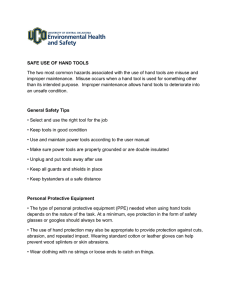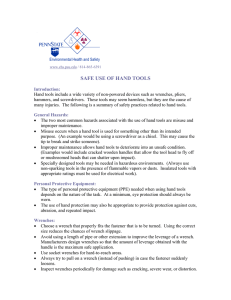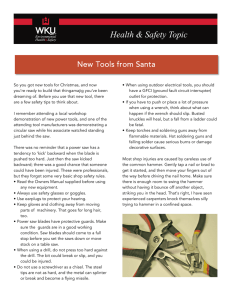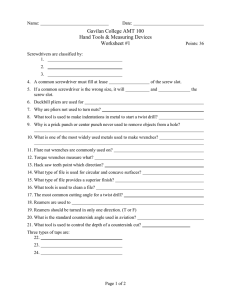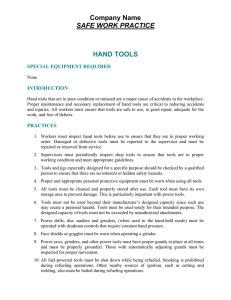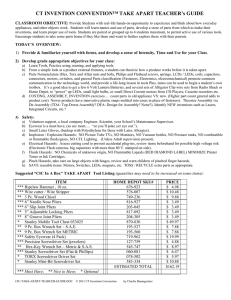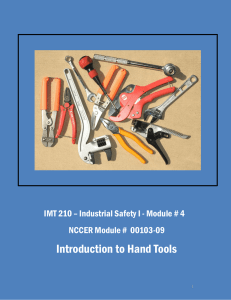General Hand Tool Safety Guidelines
advertisement
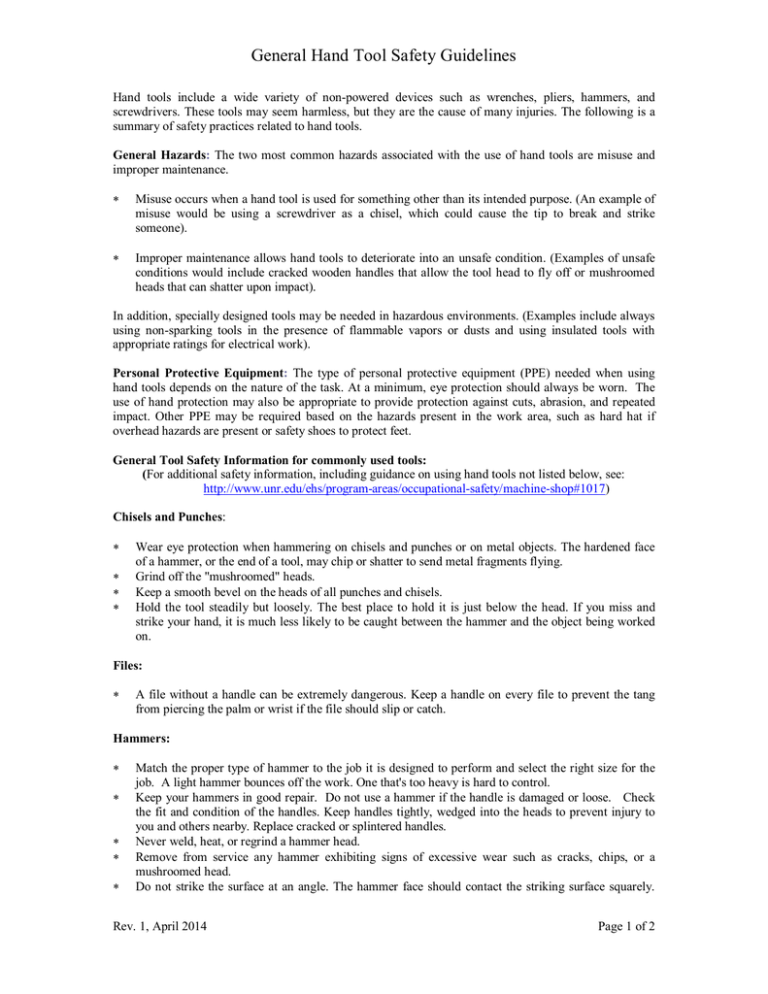
General Hand Tool Safety Guidelines Hand tools include a wide variety of non-powered devices such as wrenches, pliers, hammers, and screwdrivers. These tools may seem harmless, but they are the cause of many injuries. The following is a summary of safety practices related to hand tools. General Hazards: The two most common hazards associated with the use of hand tools are misuse and improper maintenance. ∗ Misuse occurs when a hand tool is used for something other than its intended purpose. (An example of misuse would be using a screwdriver as a chisel, which could cause the tip to break and strike someone). ∗ Improper maintenance allows hand tools to deteriorate into an unsafe condition. (Examples of unsafe conditions would include cracked wooden handles that allow the tool head to fly off or mushroomed heads that can shatter upon impact). In addition, specially designed tools may be needed in hazardous environments. (Examples include always using non-sparking tools in the presence of flammable vapors or dusts and using insulated tools with appropriate ratings for electrical work). Personal Protective Equipment: The type of personal protective equipment (PPE) needed when using hand tools depends on the nature of the task. At a minimum, eye protection should always be worn. The use of hand protection may also be appropriate to provide protection against cuts, abrasion, and repeated impact. Other PPE may be required based on the hazards present in the work area, such as hard hat if overhead hazards are present or safety shoes to protect feet. General Tool Safety Information for commonly used tools: (For additional safety information, including guidance on using hand tools not listed below, see: http://www.unr.edu/ehs/program-areas/occupational-safety/machine-shop#1017) Chisels and Punches: ∗ ∗ ∗ ∗ Wear eye protection when hammering on chisels and punches or on metal objects. The hardened face of a hammer, or the end of a tool, may chip or shatter to send metal fragments flying. Grind off the "mushroomed" heads. Keep a smooth bevel on the heads of all punches and chisels. Hold the tool steadily but loosely. The best place to hold it is just below the head. If you miss and strike your hand, it is much less likely to be caught between the hammer and the object being worked on. Files: ∗ A file without a handle can be extremely dangerous. Keep a handle on every file to prevent the tang from piercing the palm or wrist if the file should slip or catch. Hammers: ∗ ∗ ∗ ∗ ∗ Match the proper type of hammer to the job it is designed to perform and select the right size for the job. A light hammer bounces off the work. One that's too heavy is hard to control. Keep your hammers in good repair. Do not use a hammer if the handle is damaged or loose. Check the fit and condition of the handles. Keep handles tightly, wedged into the heads to prevent injury to you and others nearby. Replace cracked or splintered handles. Never weld, heat, or regrind a hammer head. Remove from service any hammer exhibiting signs of excessive wear such as cracks, chips, or a mushroomed head. Do not strike the surface at an angle. The hammer face should contact the striking surface squarely. Rev. 1, April 2014 Page 1 of 2 General Hand Tool Safety Guidelines Glancing blows made with a hammer often lead to injury. Pliers: ∗ ∗ ∗ ∗ ∗ Do not increase the handle length of pliers to gain more leverage. Use a larger pair of pliers or bolt cutters. Do not substitute pliers for a wrench when turning nuts and bolts. Pliers cannot grip these items properly and will slip. Never use pliers as a hammer or hammer on the handles. Such abuse is likely to result in cracks or breaks. Cut hardened wire only with pliers designed for that purpose. Always cut at right angles. Never rock from side to side or bend the wire back and forth against the cutting edges. Screwdrivers: ∗ ∗ ∗ ∗ ∗ Never use a screwdriver as a pry bar, chisel, punch, stirrer, or scraper. Always use a screwdriver tip that properly fits the slot of the screw. Throw away screwdrivers with broken or worn handles. Use magnetic or screw-holding screwdrivers to start fasteners in tight areas. Never use pliers on a screwdriver for extra leverage. Only use a wrench on screwdrivers specifically designed to accept them. Utility Knives/Blades: ∗ ∗ ∗ ∗ Always use a sharp blade. Dull blades require more force and thus are more likely to slip. Replace the blade when it starts to “tear” instead of cut. Never leave a knife unattended with the blade exposed. Consider using a self-retracting knife with a spring-loaded blade. (The blade will retract when pressure on the knife is released). Keep your free hand away from the line of the cut. Don’t bend or apply side loads to blades by using them to open cans or pry loose objects. Blades are brittle and can snap easily. Wrenches: . ∗ When possible, use the open palm of your hand to push on the wrench. When this is not possible, pull the wrench toward you. This may prevent the wrench from slipping to cut or skin your knuckles. ∗ Make sure that the wrench is the proper size for the bolt or nut to be turned. Using the correct size reduces the chances of wrench slippage. ∗ Use socket wrenches for hard-to-reach areas. ∗ When using adjustable "wrenches, keep the open jaw of the adjustable wrench facing toward you. This forces the movable jaw onto the nut to reduce its tendency to slip. It also prevents damage to the wrench. ∗ Avoid using a length of pipe or other extension to improve the leverage of a wrench. Manufacturers design wrenches so that the amount of leverage obtained with the handle is the maximum safe application. ∗ Inspect wrenches periodically for damage such as cracking, severe wear, or distortion. Rev. 1, April 2014 Page 2 of 2
